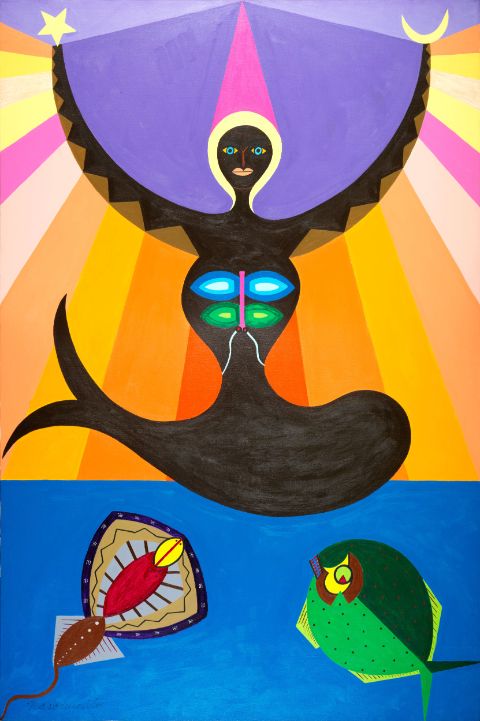Abdias Nascimento

Abdias Nascimento, Oxunmaré Ascende (Oshunmare Rising, 1972), painting, acrylic on canvas, 152 × 102 cm. IPEAFRO Black Art Museum Collection, digital reproduction by Miguel Pacheco e Chaves, RCS Arte Digital
Artist, author, and activist Abdias Nascimento is one of the most crucial figures in the Afro-Brazilian and African worlds. A prolific practitioner from the 1940s onwards, Nascimento jointly developed a pluriversal modernism and a philosophy of quilombismo. Working at the intersection of politics and arts, he advocated for racial equality and the affirmation of African epistemologies as knowledges of aesthetic, political, and spiritual worlds that resisted (neo)colonialism. In the Brazilian context, Nascimento contested the myth of ‘racial democracy’ that denied structural racism within society and embraced the anti-colonial movements of Négritude and Pan-Africanism to vindicate African cultures through global solidarity. Based in Rio de Janeiro, Nascimento founded the Teatro Experimental do Negro (1944), the newspaper Quilombo (1948), the Museu de Arte Negra (1950), and the IPEAFRO (1981), among other initiatives. His pictorial works emerged while he was in exile in the US (1968–81) during Brazil’s dictatorship. Against the extractivist, formalist, and colonial concepts of ‘primitivism’, ‘pure abstraction’, and ‘universalism’ of western modernism, his paintings are an ‘act of love’ that express the agency and situated realities of African beings. Encompassed within them are symbols of the orishas, the spirits of the Afro-Brazilian Candomblé religion, the adinkra ideograms of West Africa or aphorisms of ancient Egypt, and contemporaneous quilombist struggles, such as the war of independence in Angola (1961–74).
HKW wishes to sincerely thank IPEAFRO / Afro-Brazilian Studies and Research Institute for their collaboration.
Works in the exhibition: Ponto Riscado da Liberdade (Sacred Sign for Freedom) (1974), painting, acrylic on canvas, 202 × 102 cm; Quilombismo (Exu e Ogum) (Kilombism (Eshu and Ogun)) (1980), painting, oil on canvas, 71 × 56 cm; Afro Estandarte (African Standard) (1993), painting, acrylic on canvas, 80 × 50 cm; Teogonia Afro-Brasileira n. 2: Iansã, Obatalá, Oxum, Oxóssi, Yemanjá, Ogum, Ossaim, Xangô, Exu (Afro-Brazilian Theogony n. 2: Iansan, Obatala, Oshun, Oshossi, Yemanja, Ogun, Osanyin, Shango, Eshu) (1972), painting, acrylic on canvas, 102 × 152 cm; Baía de Sangue (Luanda) (Bay of Blood (Luanda)) (1996), painting, acrylic on canvas, 80 × 100 cm; Oxunmaré Ascende (Oshumare Rising) (1972), painting, acrylic on canvas, 152 × 102 cm. Courtesy of Instituto de Pesquisas e Estudos Afro-Brasileiros IPEAFRO Museu de Arte Negra